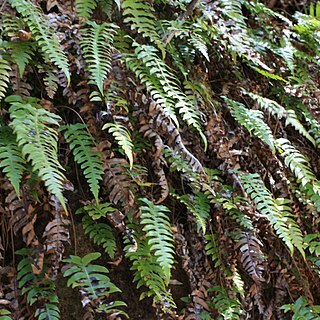Rhizome creeping to erect often forming a short caudex up to 20 by 3 cm clothed with the densely scaly bases of the old stipes and supporting a small crown of fronds and also under some conditions giving rise (from the growing rhizome apex, and above the ground) to a slender creeping stoloniferous rhizome 0.2-0.3 cm diam. and clothed in narrow triangular, acuminate, entire, reddish brown scales, and on most specimens uniseriate multicellular hairs. Fronds dimorphic, erect or pendulous, 10-70 by 3-30 cm, fertile fronds usually longer than sterile fronds. Stipes usually about half the length of the whole frond, often longer for fertile fronds, 5-40 cm, slender, stramineous to brown, pilose in most specimens, densely and persistently scaly at the base; (hairs sometimes absent at the base of the stipe); scales less dense and less persistent further up the stipe; scales linear to narrow triangular, acuminate, 1-2.5 by 0.1-0.3 cm, entire, concolorous dark reddish brown, shiny, deciduous scales leaving a distinct raised dark scar on the otherwise pale stramineous stipe; hairs sometimes abundant, intermingled with the scales, uniseriate, 0.1-0.35 cm in length, straight, pale or white, varying from sparse and mostly deciduous to dense and persistent. Lamina narrowly to broadly elliptic or deltoid, dull green, pinnatisect to pinnate, 6-30 or more pairs of pinnae. Rhachis and costae stramineous to brown, occasionally glabrous but usually pilose, with persistent fine, uniseriate, straight, pointed pale or white hairs, to c. 0.1 cm long and to c. 7 cells. Sterile pinnae oblong to narrowly triangular, often slightly falcate, obtuse (especially in smaller fronds), acute or acuminate (especially in larger fronds), 4-8 by 0.7-1.5 cm, fully adnate throughout except for basiscopic side of lowest pair of pinnae, coriaceous, yellow-green in fresh material, sometimes pilose on both surfaces but usually more so on the abaxial surface (hairs similar to those of stipe, rhachis, and costae); veins free, furcate, margins thickened, crenate, sometimes fringed with hairs, basal pinnae broader, more falcate, markedly deflexed and not adnate basiscopically. Fertile pinnae narrower 0.4-0.6 cm in width and spaced on the rhachis, indusium sometimes with associated uniseriate hairs; hairs often also arising from the margin of the pinnae. Spores 42.5 by 32.7 µm (from 18 herbarium specimens), perine scabrous to rugulose, exine smooth to granulose or microverrucose.
More
Rhizome stout, erect, invested by bases of fallen stipites, densely clad in dark brown subulate-attenuate paleae c. 1 cm. long; stipites tufted. Stipes pale brown, stiff, paleate towards base, ± asperous, ± compressed, 5-20-(35) cm. long. Rhachis stout, grooved, bearing numerous pinnae. Sterile lamina coriac., dull green, deltoid-oblong to-lanceolate, acute to acuminate, 10-35 × 5-12 cm.; ± softly pilose, margins crenulate to subentire, thickened; pinnatifid in apical portion. Pinnae approximate; lowest hardly diminished in size, often deflexed; largest 3-6 cm. × 5-10 mm., lanceolate-oblong to oblong, acute to obtuse, straight to falcate, attached by widened base; veinlets evident, us. forked. Fertile lamina up to 40 cm. long, with distant linear pinnae up to 5 cm. long, often arcuate; base somewhat widened. Sori covering all but costa, indusium becoming ± erose.
Rhizome creeping to erect, often forming a short trunk. Fronds dimorphic, 10-68 cm long, 3-10 cm wide. Stipe 9-36 cm long, stramineous to brown; scales linear to narrowly triangular, acuminate, entire, dark reddish brown, with straight white hairs at least at base of stipe. Lamina narrowly triangular, pinnatisect or pinnate, with 6-30 or more pairs of pinnae; rachis and costae stramineous to brown, glabrous in Australian material; sterile pinnae oblong to narrowly triangular, often slightly falcate, acuminate, 3.2-8 cm long, 8-10 mm wide, sometimes pilose, fully adnate; margins crenate; basal pinnae broader, more falcate, markedly deflexed and not adnate basiscopically; fertile pinnae 3-4.5 cm long, 2-3.5 mm wide. Spores 38 × 29 µm; perine scaberulous; exine smooth.
A fern that grows in soil. The rhizomes is creeping or erect. It is covered with dense scales at the base. The leaves are of 2 forms. The young leaves are usually reddish.

